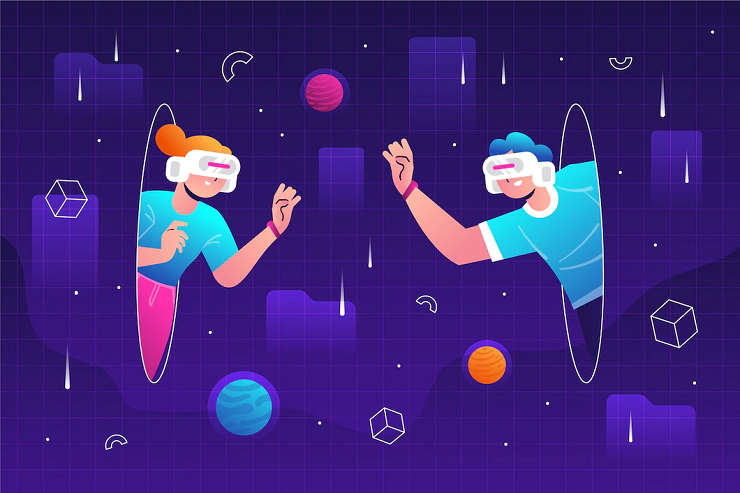
Many people associate Virtual Reality (VR) with science fiction films. However, the truth is that this technology is now completely integrated into our daily lives. Virtual reality is here to stay in video games, medicine, and education. But what exactly is it?
What Exactly Is Virtual Reality?
Virtual Reality (VR) is a computer-generated environment with realistic-looking scenes and objects that immerses the user in their surroundings. This environment is perceived by using a Virtual Reality headset or helmet. VR enables us to immerse ourselves in video games as if we were one of the characters, learn how to perform heart surgery, and improve the quality of sports training to achieve peak performance.
Even though it might appear to be very far in the future, its beginnings are not as recent as we might believe. Many people believe that the Sensorama, a machine with a built-in seat that played 3D movies, released odors, and produced vibrations to make the experience as lifelike as possible, was one of the first Virtual Reality devices. In the middle of the 1950s, the invention was developed. Over the years that followed, software and technological advancements brought about a steady evolution in interface design and devices.
Advantages Of Virtual Reality:
The following are some of the advantages of virtual reality.
1. Virtual Reality Allows You To Explore Places Without Physically Being There:
Virtual reality is an imaginary environment created with the help of technology that has the essence of reality. It is thus beneficial to explore various locations without physically visiting them. This has made people’s lives much easier and more enjoyable. The fact that one needs more money to explore everything has enabled the introduction of virtual reality.

2. It Creates A Realistic World:
In virtual reality, the user is immersed in a world based on the subjects they are studying or enjoying themselves. The user perceives the created virtual reality as though it were the real world, even though it isn’t. Therefore, even though everything may be fictitious, it assists them in having a better understanding of the present reality.
3. Lowest Risk:
Virtual reality is an imaginary world created by the developer to study or simulate various aspects of life. As a result, the risk of gaining knowledge from books is almost non-existent. Low risk does not imply that the total risk is zero, but the consequences can vary depending on the individual’s mental ability.
4. The Educational System Has Been Improved:
The virtual study, in which a teacher teaches the student using virtual reality equipment, has taken the place of the previous text-based learning method. This equipment enables the user to visualize the hypothetical setting based on the study’s subject and conduct analysis.
5. Increases Interest And Engagement In A Subject:
Virtual reality is a platform that allows a person to experience a situation that they have studied in their textbooks. Practical knowledge is more interesting and exciting than monotonous book reading, so there has been a lot of interest in the subject of virtual reality or virtual reality training.
6. Help With Training:
Many people who are not skilled in various fields of work can receive training in a virtual environment. For example, engineering requires practical knowledge, so virtual reality technology can be used to apply knowledge.

What Is The Future Of Virtual Reality?
We anticipate that virtual reality will play an important role in our future. With so much time, labor, and money invested in this technology, expectations have risen, and here are five ways in which VR can affect us and change our future:
I) Gaming
Because of gaming, virtual reality has grown in popularity. Consider a 3D Counter-Strike game. VR has already begun to dominate this field, and many more companies have begun developing new games using VR technology. Furthermore, gaming companies are working on the concept of VR gambling to improve the user experience.
II) Traveling
Virtual reality allows you to travel the world without ever leaving your house. Yes, VR technology can transport you from your home to a completely different location. You can go shopping, travel, or socialize without leaving your house. Virtual reality technology is based on the concept of “being there without actually being there.” As a result, we can expect to see ocean waves in our homes, enjoy the sun and beach in Miami, and much more. With this technology, distant places will become your next-door neighbors.
III) Better Understanding Of Products And Services
Virtual reality can provide a more realistic real-time experience of services and products that we might want to buy. Right now, we must judge anything based on its 2D images, such as a hotel room or a travel destination. However, with the introduction of 3D virtual reality, you can view and feel the location before arriving. You can get a sense of the atmosphere before going there.

IV) Having A Movie Experience
Until recently, 3D movies ruled the box office. For the time being, you can experience 3D. But that is not the true one. VR technology will underpin true 3D. In true 3D, you can see yourself as a character in the film. You can feel the film through your choice of angle, not the cameras. Colors can be felt and a better view can be obtained. Developments have already begun, and one such cinema hall has opened in Amsterdam.
V) Improved Life Quality
Our lives will improve as virtual reality technology advances. VR technologies will make smartphones smarter, and the market will be flooded with smart tools such as VR goggles and VR devices. We can enjoy history (which is theoretically boring), explore space (from Earth), see the surface of the moon in 3D, and much more with VR. All aspects of our lives will improve and become more practical.
What Are Different Types Of Virtual Reality?
Let’s take a look at the various types of virtual reality and how they engage users in different ways.
1. Immersive Virtual Reality
Non-immersive virtual reality is a type of virtual reality in which you interact with a virtual environment, typically through a computer, and control some characters or activities within the experience, but the virtual environment does not interact with you directly.
2. Fully Immersive Virtual Reality
Non-immersive virtual reality is the polar opposite of fully immersive virtual reality. It provides a more realistic virtual experience. It will feel as if you are physically present in the virtual world and the events taking place there are taking place to you. To provide a realistic virtual experience, special equipment such as VR glasses, gloves, and body detectors equipped with sense detectors are required. The computer uses the data from these sensors, and the virtual world responds in real-time to provide users with a realistic virtual experience.

3. Semi-Immersive Virtual Reality
Between non-immersive and fully immersive virtual reality is something called semi-immersive. You can move around in a virtual environment using a computer screen or VR glasses, but other than your visual experience, there are no physical sensations to add to the immersion. A good illustration of semi-immersive virtual technology is a virtual tour. It might be web-based or device-based. This technology is being used by many businesses because it allows users to move around a space without physically being there.
4. Augmented Reality
Augmented reality is a type of virtual reality in which the user can see the real world through a phone screen and make virtual changes to it. The mobile game application Pokémon Go is a good example that will help you better understand augmented reality. You can activate your phone’s camera and point it to a location where you believe Pokémon will be found. The Pokémon would then appear on your phone screen as if it were in the photo’s frame. They only appear on your screen, and there is no physical addition to the area being filmed.
5. Collaborative VR
This is a type of virtual reality in which users from various locations can interact in a virtual environment as 3D projected characters. A virtual environment of a mobile game, such as Player Unknown’s Battlegrounds (PUBG), in which virtual 3D characters of different players come together and interact with each other’s virtual personas in that environment, is an example of Collaborative VR.
Conclusion:
To improve engagement with prospects and business modules, an increasing number of businesses are implementing various forms of virtual reality, primarily virtual tours and virtual meeting rooms. If you haven’t already, I recommend you start thinking about using virtual reality to keep up with this advanced world.
